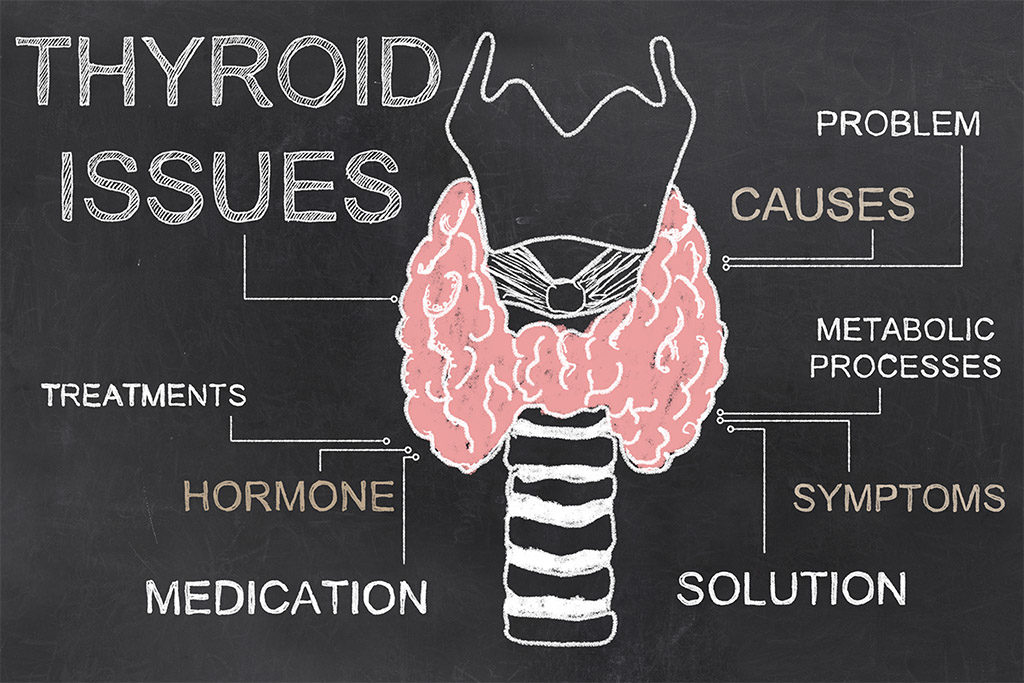

Understanding Types Of Thyroid Diseases
I’ve talked a lot about my thyroid and my healing journey that I have been on ever since my thyroid cancer diagnosis. Now I want to talk a little bit about the thyroid, what it does, how it works, and what other types of thyroid diseases there are. The little gland has some big roles in our bodies. The slightest disruption of the thyroid can lead to a myriad of symptoms or diseases. For me, thyroid health is extremely important and extremely personal. I want to make sure to share a little bit of what I know about it with everybody in the hopes that if you begin your own healing journey, you may begin with a base of knowledge to help show you the path best suited for your own healing.
What is the Thyroid?
Forgive me if it seems like this is basic knowledge. Those of you who have been with me on my own journey are already well-versed on what the thyroid is and what it does. For those who are just joining me now, they may have stumbled upon this page in their own search to try to understand what is going on in their own bodies. So I begin at the beginning.
The thyroid is a butterfly-shaped gland that sits at the base of your neck. It regulates your body’s metabolism as well as regulates growth and development. It makes three different types of hormones: thyroxine, or T4, and triiodothyronine, or T3, and calcitonin. T3 and T4 are responsible for metabolic rate. Calcitonin is involved in calcium and bone metabolism.
The thyroid itself doesn’t simply release T3 an T4 to regulate metabolism. Instead, it relies on the pituitary gland to send a signal. When T3 or T4 levels are low, the pituitary will release Thyroid Stimulating Hormone, or TSH, which will then trigger the thyroid to release more hormones. In many cases, TSH levels are used as a benchmark for overall thyroid health, which can be a problem. I’ll get into that more in a little while.
Thyroid Conditions
Almost all types of thyroid problems or diseases are broken up into two major categories—hyperthyroidism or hypothyroidism. Diseases of the thyroid will generally cause the gland to get out of whack. TSH levels will be elevated in the case of hypothyroidism, or an underactive thyroid. And TSH levels will generally be low to unmeasurable in a case of hyperthyroidism or an overactive thyroid.
It sounds confusing. It sounds like the reverse would be true—that more TSH would mean an overactive thyroid. But when you think about it, the thyroid is releasing so much T3 and T4 that the pituitary isn’t sending out TSH to trigger the thyroid to make more. Instead, the free TSH levels will decline because the pituitary doesn’t want to trigger MORE hormones to be sent out into an already flooded system.
Grave’s Disease
Former First Lady, Nancy Reagan, suffered from Grave’s Disease. It is the most common form of hyperthyroidism and is thought to be the result of a combination of genetics and environmental conditions. The condition is much more common in women than men, and because of the age of onset for typical cases (between the ages of 30 and 50), many women tend to ignore the symptoms or brush them off attributing them to changing hormones and getting older.
Symptoms often include a fast or irregular heartbeat, goiter, irregular menstruation, frequent bowel movements or diarrhea, heat intolerance, insomnia, restlessness and nervousness, and weight loss. It can also cause retracted eyelids or bulging eyes that can result in double vision and swelling around the eyes.
Traditional treatments for Grave’s Disease vary, but there are three main treatments—radioactive iodine, surgical removal, or medication. Most patients who receive treatment for Grave’s Disease will end up needing treatment for hypothyroidism later on.
The most common treatment is radioactive iodine, which involves taking a high dose of irradiated iodine pills. This treatment slowly kills off the thyroid cells, completely ablating the gland. While ablation is the most common treatment, it is one that I would personally be hesitant to try. A May 2015 study shows that patients who received radioactive iodine therapy for hyperthyroidism were at a higher risk for certain types of cancer.
Hashimoto’s Thyroiditis
Hashimoto’s Thyroiditis is the leading cause of hypothyroidism and is the most common thyroid disorder in America. It is an autoimmune disorder which occurs when the immune system attacks the thyroid. When the thyroid becomes damaged, it will stop sending out sufficient levels of T3 and T4, which causes the pituitary to continue releasing a constant stream of TSH in order to try to increase production of the hormones. Women are also more likely to suffer from Hashimoto’s than men, and it generally strikes women between the ages of 40 and 60.
Symptoms of the autoimmune disorder are the opposite end of the spectrum from Grave’s Disease. Tiredness, weight gain, cold intolerance, constipation, slowed heart rate, heavy or irregular periods, and memory problems.
Treatments will vary depending on the progress of the disease. If too much of the thyroid is damaged from the immune system attacking it, then thyroid replacement medication may be recommended. The standard treatment medication is known as levothyroxine and has been used to treat hypothyroidism since the 1970’s. However, a 2011 study indicates that a number of patients whose T3 and T4 levels and TSH levels appear to be within normal range still report a poor quality of life. A later study done in 2015 shows the reason why might be due to the fact that levothyroxine doesn’t normalize T3 levels completely in around 12% of patients on the medication. That leaves a large portion of the population who still feel the physical and psychological effects of an underactive thyroid even with medication.
Goiter
A goiter occurs when the thyroid gland becomes enlarged. It develops because the whole gland is swollen or because several nodules have grown on in. Some people with goiters have no symptoms. Others may experience symptoms of either hypothyroidism or hyperthyroidism, depending on how their thyroid reacts.
Causes of goiter can vary as well. They may range from an iron deficiency to thyroid cancer. Hashimoto’s Thyroiditis, thyroiditis, nodules, and Grave’s Disease are other possible causes of the condition.
Treatment will also depend largely on the cause. If it is a result of an iodine deficiency, treatment may involve an iodine supplement as well as levothyroxine to replace thyroid hormones. If the goiter is a result of Hashimoto’s or Grave’s, then treatment will involve treating those conditions. If the goiter is asymptomatic, it may be left untreated altogether.
De Quervain’s Thyroiditis
This type of thyroiditis is fairly rare. It presents with pain and inflammation in the area of the thyroid gland. Patients with this type of thyroid condition end up with an overactive thyroid gland and will feel symptoms associated with hyperthyroidism.
Additional symptoms that set De Quervain’s apart from other types of thyroiditis is fever and extreme tenderness of the throat. In many cases, an oral steroid will be prescribed to relieve pain and fever.
The thyroid disorder is generally treated symptomatically. It resolves itself within a few weeks and most patients never have a recurrence. Occasionally, with prolonged cases, thyroid hormone replacement is required if a patient becomes hypothyroid throughout the course of the thyroid disease.
Silent Thyroiditis
This is another unique thyroid disorder in that it presents as a combination between Hashimoto’s and De Quervain’s. It most commonly occurs in younger women during the post partum period. Most women who suffer from silent thyroiditis will experience symptoms of hyperthyroidism as in Grave’s or De Quervain’s. But an uptake scan or a biopsy will show more similar results to Hashimoto’s. It is the most rare type of thyroiditis, but in 80% of patients, the disease runs its course within 3 months and no treatment is necessary.
Thyroid Cancer
There are several different types of thyroid cancer. The most commonly diagnosed type is papillary thyroid cancer with women being three times more likely to be diagnosed with it than men with women between the ages of 25-60 at the highest risk. There are a number of different causes of thyroid cancer, and I feel there is a strong emotional connection to the thyroid.
Other risk factors for thyroid cancer include radiation exposure (which is also the treatment for thyroid cancer), iodine intake, obesity and diabetes, estrogen levels and reproductive factors, and Hashimoto’s thyroiditis.
In most cases, treatment for thyroid cancer will involve radiation, surgery, chemotherapy, thyroid hormone therapy, targeted therapy, or watchful waiting. The treatment options are very personal to the individual. For me, my therapy choice was a no-brainer. I knew I didn’t want to expose myself to a treatment that is known to cause cancer. That meant chemotherapy and radiation were out of the question. I feel very strongly that my decision to treat the thyroid cancer with nourishing my body and focusing on healing in all aspects of my life was the best decision for myself and my family.
The good news about thyroid cancer is that it is, for the most part, very treatable. When you select the right treatment for you, the survival rate is nearly 98%. The downside is that a not-insignificant portion of those who are treated and “cured” of their thyroid cancer will continue to have thyroid cancer after their initial thyroid cancer surgery.
Final Thoughts
There are a lot of other thyroid conditions that are out there that I didn’t touch on. There is also a lot of information I touched on that I didn’t go in-depth on because it is just so much information. What I can say is this: there is without a doubt a major connection between what we eat, where we live, and how we live and thyroid disease. The thyroid itself is a puzzle and I’m just learning where some of the pieces go myself. It is a complex little gland that has an impact on every single process in our bodies.

hey there
I'm Karen!
I have found my cancer journey to be a positive and profound transformational experience. I’m inspired to share my healing journey here, and trust you’ll find hope, encouragement and purpose as you discover the healing power that lies within you.
Join
The Mailing List!
By signing up for my newsletter, you agree with our Privacy Policy and Terms & Conditions.


